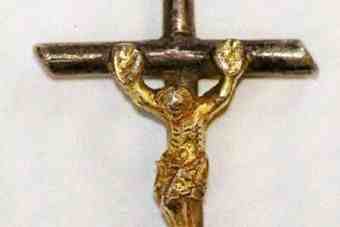A silver and gold medieval artifact discovered in a field by a Dorset treasure hunter could find a permanent home in the county.
 The crucifix, which was unearthed in January 2010 from a field in Winterborne Muston, and could be 550 years old, was described as "perfect" by a coroner at a treasure hearing in Dorchester.
The crucifix, which was unearthed in January 2010 from a field in Winterborne Muston, and could be 550 years old, was described as "perfect" by a coroner at a treasure hearing in Dorchester.
But the piece failed to impress the British Museum's curator of medieval collections James Robinson, who called the artistry "crude".
The item, found beneath 6in of ploughed earth by John Sharp, of Parkstone, has been declared treasure and will be sold to the highest bidder following a valuation by experts.
Dorset County Museum is understood to have expressed an interest in acquiring it.
Senior archaeologist for Dorset County Council Claire Pinder said she would support a plan to keep the unique object in Dorset.
She told a treasure inquest in Dorchester: "One of the great things about the Treasure Act is it makes it very clear that local museums, as well as national museums, should have an opportunity to acquire important finds.
"Locals should have a chance to acquire things that are of significance for us here in Dorset."
Several theories were put forward as to the purpose and origin of the item.
Although its size, 37mm long and 28mm wide, suggests it was a pendant, it may have been used as a decorative ornament such as those found on the front of books and boxes.
It could have come to rest in the field from a nearby medieval cottage, or from Tarrant Crawford Abbey. Mr Robinson said: "Though no unambiguous trace of a suspension loop exists, the top of the vertical shaft is flattened and may have been attached to something.
"The cross-terminals are cut at an angle, probably to simulate logs cut from a tree.
"The figure of Christ hangs from the cross in a Y-shape, with a twisted body and head hung low. The rib cage is exposed and the navel protuberant. The modelling of the figure is crude.
"The cross appeared ungilded but the figure of Christ was originally entirely gilt, although areas of wear now expose the silver beneath the layer of gilding. It dates from the late 15th or early 16th century."
Under the terms of the Treasure Act, the proceeds of the sale will be split between Mr Sharp and the owner of the field. As yet no reliable estimate has been made of its value.
Ms Pinder said: "It is a lovely little object. We are familiar with coming across coins or small personal ornaments, but a lot of them are very damaged, so a find like this is unusual."
Coroner Michael Johnston, who presided over the inquest to decide whether the item should be declared as treasure, said: "This is a perfect item. It really is quite special."
Source: This is Dorset [December 31, 2010]